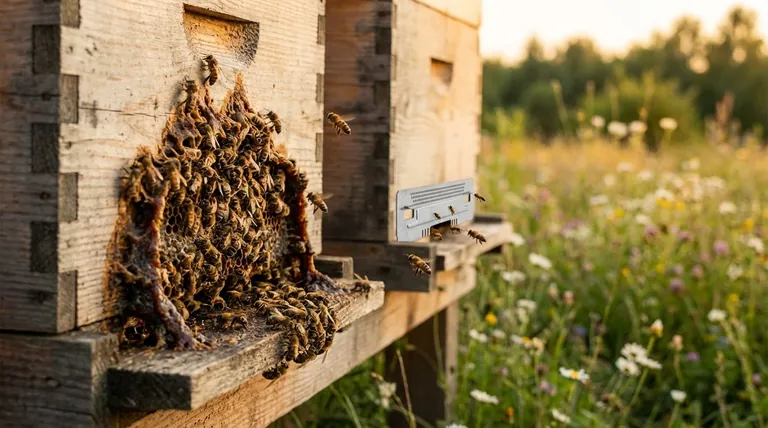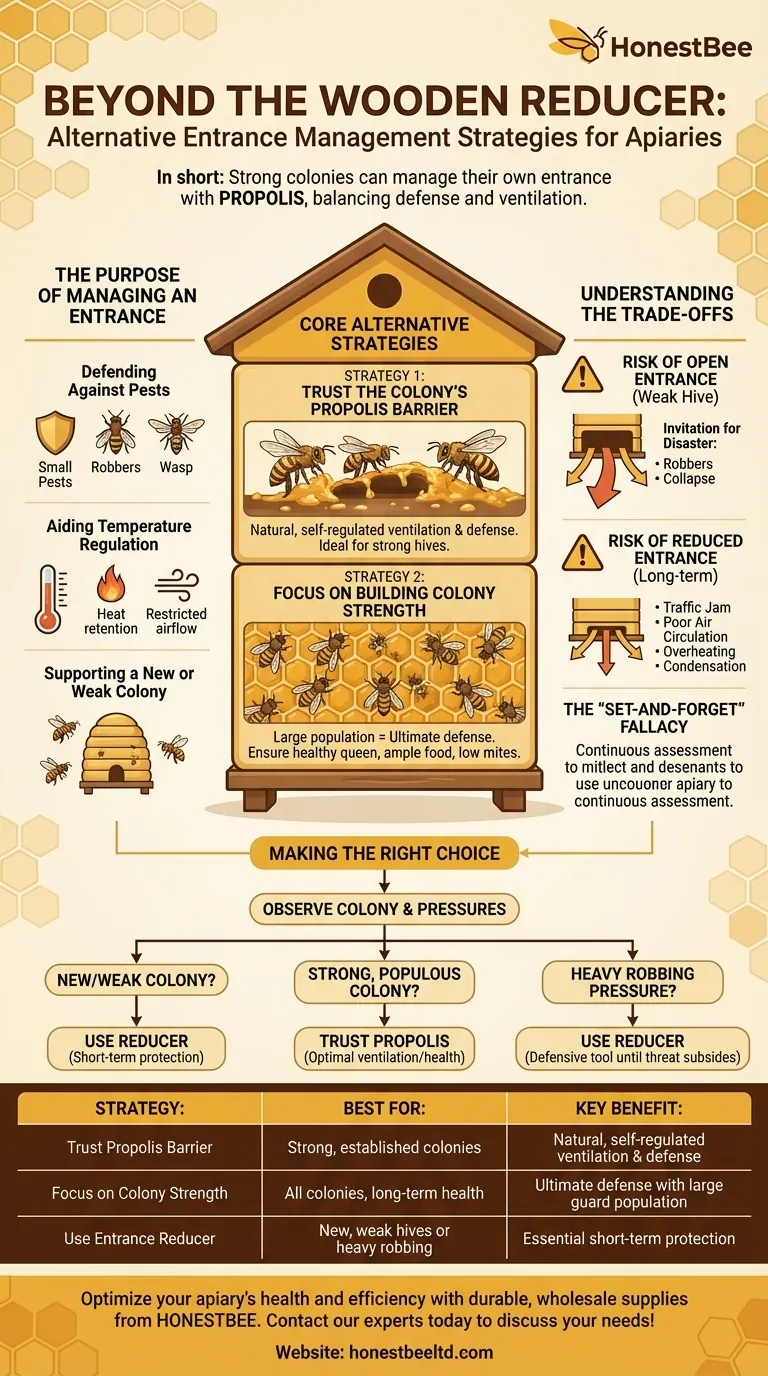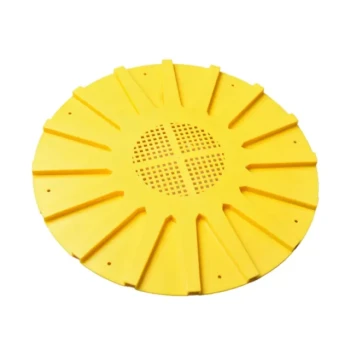In short, the primary alternative to a standard entrance reducer is to allow a strong, healthy colony to manage its own entrance. Bees are highly capable of defending their hive and will naturally use propolis to shrink the entrance to their preferred size, especially for winter, while maintaining the ventilation they need.
The decision to use an entrance reducer is not a simple yes-or-no question. It is a dynamic assessment of your colony's specific needs, balancing the hive's defensibility against its critical need for ventilation and traffic flow.

The Purpose of Managing an Entrance
To understand the alternatives, we must first understand the function of an entrance reducer. It is a temporary tool used to solve specific, short-term problems.
Defending Against Pests and Robbers
A smaller entrance is easier for a colony to guard. This is crucial when the hive is weak or when there is intense pressure from robbing honeybees, wasps, or other pests.
Aiding Temperature Regulation
In very cold climates, a reduced entrance can help the colony retain heat. However, it also restricts airflow, which is vital for managing internal moisture.
Supporting a New or Weak Colony
A newly installed package, a small nucleus hive, or a colony recovering from disease has a smaller population. Reducing the entrance gives this smaller workforce a defensible advantage until their numbers grow.
Core Alternative Strategies
Relying on a piece of wood is not the only option. Experienced beekeepers often adopt more hands-off strategies that empower the bees themselves.
Strategy 1: Trust the Colony's Propolis Barrier
A healthy, established colony knows how to manage its own home. Bees will gather propolis—a resinous plant material—and use it to construct their own entrance reducer.
This self-made barrier is perfectly sized to their needs and is often less restrictive than a wooden reducer, allowing for better ventilation. This is the most common and effective alternative for a strong hive.
Strategy 2: Focus on Building Colony Strength
The most powerful alternative to an entrance reducer is a populous, thriving hive. A large population of guard bees is the ultimate defense.
Instead of focusing on the entrance, focus on hive health: ensure they have a productive queen, ample food stores, and are free from significant mite pressure. A strong colony can defend a full-sized entrance against most threats.
Understanding the Trade-offs
Neither using a reducer nor leaving the entrance open is a universally "correct" answer. The right choice is situational and requires understanding the risks of each approach.
The Risk of an Open Entrance
For a weak hive, a fully open entrance is an invitation for disaster. It can be quickly overwhelmed by robbers, leading to the colony's collapse. This is the primary reason entrance reducers exist.
The Risk of a Reduced Entrance
Leaving a reducer on for too long can be just as harmful. It creates a traffic jam, limiting the foragers' ability to bring in nectar and pollen.
Most critically, it severely restricts air circulation. This can lead to overheating in the summer and a dangerous buildup of condensation in the winter, which can be more deadly to the cluster than the cold itself.
The "Set-and-Forget" Fallacy
Entrance management is not a one-time decision. The needs of the hive change with the seasons, the weather, and the colony's population. Regularly check the entrance and be prepared to remove or add a reducer as conditions dictate.
Making the Right Choice for Your Hive
Your decision should be based on direct observation of your colony's strength and the immediate environmental pressures it faces.
- If you have a new, small, or weak colony: Using an entrance reducer is the safest strategy to protect it from being robbed while it builds its population.
- If you have a strong, established, and populous colony: Trusting the bees to manage their own entrance with propolis is often the best choice for optimal ventilation and hive health.
- If you observe heavy robbing pressure from other hives or wasps: A reducer is a valuable defensive tool, even for a strong colony, until the threat subsides.
Ultimately, observing your bees' behavior at the entrance is your most reliable guide to their needs.
Summary Table:
| Strategy | Best For | Key Benefit |
|---|---|---|
| Trust Propolis Barrier | Strong, established colonies | Natural, self-regulated ventilation & defense |
| Focus on Colony Strength | All colonies, long-term health | Ultimate defense with a large population of guard bees |
| Use Entrance Reducer | New, weak hives or heavy robbing pressure | Essential short-term protection for vulnerable colonies |
Optimize your apiary's health and efficiency with the right equipment. At HONESTBEE, we supply commercial apiaries and beekeeping equipment distributors with durable, wholesale-focused supplies designed to support strong, self-sufficient colonies. Let us help you build a more resilient operation. Contact our experts today to discuss your needs!
Visual Guide

Related Products
- Beehive Entrance Reducer Guardian Metal Hive Entrance for Bees
- Multi-Functional Sliding Hive Entrance for Beekeeping
- Multi-Functional Rotary Hive Entrance Disc for Beekeeping
- Professional Reversible Beehive Hive Entrance
- Professional Galvanized Hive Strap with Secure Locking Buckle for Beekeeping
People Also Ask
- What should be done after transferring frames to the new hive? Essential Steps for a Secure Colony
- How can a Langstroth hive entrance be adjusted? Mimic Natural Bee Preferences for a Healthier Hive
- What are the features of the side with oblong holes in the entrance reducer? A Guide to Hive Defense & Health
- What is the purpose of placing an object in front of the hive entrance after a move? A Guide to Forced Reorientation
- What are the different types of entrance reducers available? A Guide to Protecting Your Hive


















